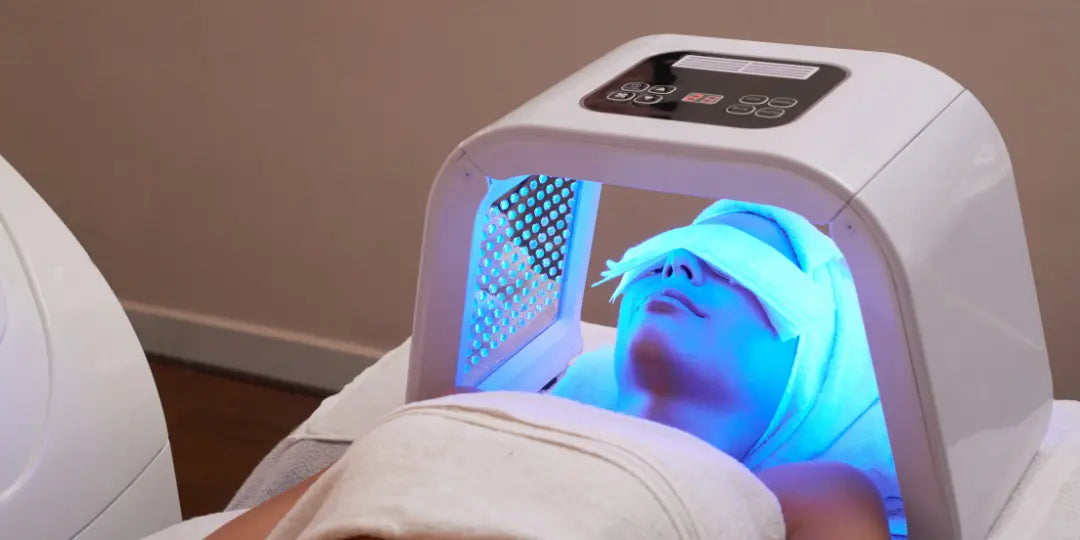Light therapy is a natural treatment method that has been increasingly used in recent years. This is particularly true for combating "winter depression" (or any seasonal affective disorder). In fact, it involves exposing yourself to strong light to compensate for the lack of sunshine in the winter months. But what are the precautions and contraindications to know about light therapy? Let us guide you!
Learn more about light therapy
What is it about?
Light therapy, also called phototherapy , is a practice that consists of exposing oneself to artificial light , the latter being specially designed to simulate the natural brightness of the sun . It is indeed through a specific device (usually a lamp or a light box) that white light is emitted, which can reach a light intensity of 10,000 lux. And it is this exposure that makes it possible to compensate for the lack of natural light observed in winter.
It is also important to know that the devices used in light therapy are manufactured in such a way as to block ultraviolet rays , which are known to be harmful to the skin and eyes. Thus, the light produced at intensities controlled by the devices is just white or blue, and does not present any risk of burning or aggression .
What are the therapeutic applications?
While light therapy is primarily used to treat seasonal affective disorder, this type of therapy has other benefits as well. To give you an idea, here is a list of the areas where light therapy is used today:
- Seasonal Affective Disorder (SAD) : This is the primary use of light therapy. And exposure to bright light helps reduce SAD symptoms (low motivation, less energy, depressed mood, etc.).
- Sleep disorders : whether to reduce insomnia or help recover from jet lag, light therapy can be effective. This practice can indeed help restore regular sleep cycles.
- Non-seasonal depression : This is a lesser-known benefit, but when combined with other treatments, light therapy may help improve patients' mood and thus treat non-seasonal depression.
- Other potential applications : Today, studies are also exploring the results of light therapy on disorders such as anxiety, post-traumatic stress and even premenstrual syndrome.
Some precautions for use
Adopt the right dosage and intensity of light
For safe phototherapy, the dose and intensity of light are two essential aspects. Today, the standard is exposure to an intensity of 10,000 lux for a duration that can vary between 20 and 30 minutes per day . However, it is also possible to practice light therapy at a lower intensity for longer periods (for example, 2,500 lux for a maximum of 2 hours).
The intensity of the light not only affects the duration of the therapy , but also the body itself . Indeed, over-excitation or high sensitivity to bright lights can be observed following sessions that are too long or too intense. In addition, some people may experience eye fatigue or headaches if the light therapy device is used incorrectly. This is why it is essential to follow the instructions for use of the device in question, or even better, to go through a professional experienced in the field.
Choosing the right time of day
A second point to consider for the effectiveness of light therapy is the time of day at which it is practiced. Indeed, it is generally recommended to carry out phototherapy sessions in the morning . Morning exposure will help promote the production of serotonin , a hormone that plays a role in regulating mood and maintaining energy throughout the day.
On the contrary, when used late in the day or in the evening, light therapy can prevent the release of melatonin. Thus, the circadian rhythm can be disrupted, and this can lead to difficulty falling asleep.
Position yourself at a suitable distance from the device
Finally, one last point to consider to maximize the benefits of light therapy is the distance between the face and the light source . As a general rule, it is recommended to stay between 30 and 60 cm from the lamp or box used. This distance allows for optimal exposure, without the risk of visual fatigue or eye irritation.
Do not try to bring your face closer thinking that the device will have a more intense effect! This could lead to overexposure and you could feel visual discomfort. It is also not recommended to stare at the lamp to avoid tiring your eyes. Prefer to position the device on the side for indirect exposure.
Contraindications to light therapy
Specific medical conditions
It is true that light therapy has various benefits, but you should also take precautions before using this method. Indeed, certain medical conditions may be incompatible with this type of therapy, making it risky or even dangerous. Here is a list of the main contraindications:
- Eye diseases : If you have eye disorders (glaucoma, cataracts, macular degeneration), it is essential to consult an ophthalmologist before using phototherapy. You may suffer additional eye damage from prolonged exposure to bright light.
- Photosensitivity and medications : some people are more sensitive to light than others, especially those taking medications (antibiotics, anti-inflammatories) that increase photosensitivity. In these cases, light therapy is not recommended, as it may cause skin reactions or visual disturbances.
- Bipolar disorder : People with bipolar disorder should consult a healthcare professional before attempting light therapy. This is because it can sometimes trigger mania or hypomania in people with bipolar disorder.
Groups of people at risk
Apart from the medical conditions listed above, certain groups of people also need to take extra precautions when using light therapy. These include:
- Children and adolescents : their skin is often more sensitive to light, which is why the advice of a pediatrician is necessary before starting treatment.
- Pregnant and breastfeeding women : There is no scientific evidence that light therapy is harmful to pregnant or breastfeeding women. However, caution should be exercised.
- Elderly : With age, the eyes become more sensitive, and some elderly people may suffer from eye diseases. Prior consultation with a professional is therefore recommended.
Conclusion
In conclusion, light therapy is an effective and natural method to compensate for the lack of light, especially during the winter. However, certain precautions must be taken for safe practice, particularly with regard to the intensity and duration of exposure, the time of the session, and the distance from the device. It is also advisable to consult a professional before starting any treatment, particularly in the event of medical conditions or if you are one of the people at risk.




